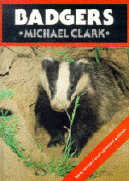Out of the Woods for Badger Numbers

New Scientist - 23 August 1997
By Stephanie Pain
 Badgers,
persecuted to near extinction in many parts of Britain, have made
a remarkable recovery over the past nine years. A survey carried
out between October 1994 and January 1997 shows a 77 per cent
increase in the number of badgers since a similar survey in the
1980s. Badgers,
persecuted to near extinction in many parts of Britain, have made
a remarkable recovery over the past nine years. A survey carried
out between October 1994 and January 1997 shows a 77 per cent
increase in the number of badgers since a similar survey in the
1980s.
"The recovery is almost certainly due to much
lower levels of persecution," says Steve Harris, a mammal
specialist at the University of Bristol. But there are already
signs that the soaring numbers could trigger a backlash from
farmers worried about the threat to their cattle from TB, a
disease that infects both species. And the best badger habitat
seems to be shrinking rapidly, which could limit further recovery.
For the survey, an army of volunteers and
professional biologists covered 2578 1-kilometre squares of
countryside, 93 per cent of them the same as in the earlier study.
A report of the survey, by Harris and his colleagues Gavin Wilson
and Graeme McLaren, is published this week by the People's Trust
for Endangered Species.
Although the number of badgers has increased
dramatically, the species is only slowly moving into new areas.
"A group has to reach a certain size before you get dispersal
into new areas and most still haven't reached that size,"
says Harris. Nevertheless, there are now around 50 000 groups of
badgers, an increase of 24 per cent since the 1980s.
The extent of the recovery varies from region to
region (see Map). The largest increase is in the West Midlands,
where the number of badger groups rose by 86 per cent. In northern
England and southern Scotland, where persecution is still rife,
there is little sign of recovery and even a decline in some
places.
Recovery is almost wholly a result of the
reduction in snaring, shooting and digging. The tough penalties
for killing badgers since the Protection of Badgers Act of 1992
have been an effective deterrent in many regions, but not all.
"In northern England we found that 25 per cent of breeding
setts were dug," says Harris. Fox hunts also continue to
block the entrances to setts to prevent foxes going to ground.
A simple computer model of population growth shows
that the increase can be explained by the survival of one more
adult badger per group rather than increased fertility, which
supports the idea that long-term persecution had kept badger
numbers down. "A small change in mortality leads to a big
increase in population," says Harris.
Not all the news is good. The survey reveals that
the number of kilometre squares considered ideal for badgers has
declined. In the earlier survey, 39 per cent of squares were rich
enough in different habitat features to constitute
"good" badger country. This time, the proportion has
fallen to 31 per cent. "The countryside is getting poorer and
if it carries on like this we will start to see a decline in
numbers again," says Harris.
The new badger-friendliness of farmers may also be
short-lived. According to the report, local badger conservation
groups are finding that attitudes are hardening again. Although
there is circumstantial evidence that badgers can transmit TB to
cattle, no one knows exactly how. A panel chaired by John Krebs,
head of the Natural Environment Research Council, will advise the
government on the issue of badgers and TB this autumn.
Brian Jennings, chairman of the Animal Health and
Welfare Committee of the National Farmers Union, denies that
farmers are anti-badger, but he considered the size of the
increase in the West Midlands "bad news". "Where
there is a suspicion that the population is becoming too big for
the habitat, farmers should be allowed to apply for a reduction
licence," says Jennings.
Research by the Ministry of Agriculture in
Gloucestershire suggests that the badger boom will not lead to a
spread of TB. The study, at Woodchester Park, which has the
highest density of badgers in the country, has shown there is no
link between the density of the animals and the level of TB
infection (Journal of Zoology, vol 242, p 705).
The survey has also shown that the badger of The
Wind in the Willows, a secretive woodland animal, is a myth.
Badgers have simply taken refuge for most of this century in
places where people couldn't get at them. "If the habitat is
there, they will colonise it, says Harris. Once you stop hammering
them they'll live in lots of places."
For the full text of this story, click the
following link:
| Michael Clark
book |
 |
This is a superb book about badgers by Michael
Clark. His immense knowledge of badgers really shines through. Click here to buy:
2017 edition or
2010 edition
or
2010 edition
|
| External News |
|
We have provided links to stories from external news
organisations so you can follow the media interest in badgers, and see who
writes on the subject. We do not endorse external authors. |
 |
|
